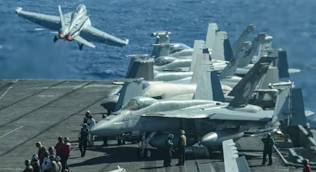In a tragic turn of events, two US Navy pilots were shot down by their own forces in the Red Sea on Sunday, in what is being described as a “friendly fire” incident.
The pilots, who were flying an F/A-18 Super Hornet fighter jet launched from the USS Harry S. Truman aircraft carrier, ejected from their aircraft and were rescued safely. One of the pilots sustained only minor injuries, while the other was unharmed.
The fighter jet was mistakenly hit by a missile fired from the USS Gettysburg, a guided missile cruiser that was part of the Truman aircraft carrier’s strike group. This led to the downing of the aircraft, in what military officials have confirmed as an error on their part.
US Central Command (Centcom) released a statement acknowledging the incident, calling it a “tragic mishap.” They also assured that an investigation would take place to determine how such a mistake could occur, with officials adding that the cause was still unclear.
“It wasn’t immediately clear how the Gettysburg could mistake an F/A-18 for an enemy aircraft or missile,” the statement read. The statement also pointed out that battle group vessels typically maintain coordinated radar and radio communication, making the error all the more puzzling.
The incident comes amid heightened tensions in the region, with US warships and aircraft engaged in intense operations against the Houthi rebels in Yemen. These rebels, who are backed by Iran, have been targeting merchant vessels in the Red Sea, making the waterway increasingly dangerous for shipping.
On the same day, the US military had intercepted several drones and an anti-ship missile launched by the Houthis, further escalating tensions in the region. In response, US forces had also carried out airstrikes on several Houthi positions, including missile storage and command-and-control facilities near Yemen’s capital, Sana’a, and the port city of Hodeida.
The Red Sea has seen growing violence in recent months, with the Houthis reportedly targeting around 100 merchant vessels since October. While the rebels claim their attacks are aimed at pressuring the US and its allies to stop supporting Israel in its conflict with Hamas in Gaza, many of the ships struck have had no connection to the Middle East conflict. Some vessels have even been on routes to and from Iran.
This incident highlights the risks posed by escalating military activity in the Red Sea, where the US is increasingly engaged in military operations to combat Houthi actions. Despite the efforts to protect maritime trade and secure the region, the “friendly fire” mistake raises concerns about the effectiveness of communication and coordination among military forces operating in such high-stakes environments.
While the pilots were fortunate to escape with only minor injuries, the incident serves as a stark reminder of the dangers faced by military personnel in conflict zones. Centcom has vowed to conduct a full investigation to determine what went wrong, and how similar incidents can be avoided in the future.
Background: The Red Sea Conflict
The Red Sea has long been a critical shipping route, connecting the Mediterranean to the Indian Ocean through the Suez Canal. In recent years, however, it has become a hotspot for military tensions, particularly with the rise of the Houthi rebels in Yemen.
The Houthis, an insurgent group, have been involved in a brutal civil war in Yemen, and their attacks on maritime vessels have been a significant part of their strategy. With the support of Iran, they have launched numerous attacks on both military and commercial ships, claiming these actions are part of their broader campaign to pressure the US and its allies. The conflict, which has drawn in regional powers, including Saudi Arabia and Iran, continues to destabilise the region.
The US, a key ally of Saudi Arabia, has responded by increasing its military presence in the region, conducting airstrikes on Houthi positions, and intercepting missiles and drones aimed at US forces or merchant vessels. This “friendly fire” incident highlights the chaotic and dangerous nature of these operations.
The incident is also a blow to the US Navy’s efforts to maintain operational effectiveness in a volatile region. It underscores the difficulty of coordinating complex military operations and the tragic potential consequences when things go wrong.

